Published on: 09th October 2025
Authored by: Jahnavi Raghu
PES University
Introduction
The case of Union Carbide Corporation v. Union of India arose from one of the world’s worst industrial disasters—the Bhopal Gas Tragedy of December 1984. The legal battle that ensued raised fundamental questions about corporate liability, transnational legal jurisdiction, and adequate compensation for mass disasters. The case represents a landmark in international environmental law and corporate accountability, establishing important precedents for handling industrial disasters across jurisdictional boundaries.
Facts of the Case
On the night of December 2-3, 1984, a lethal methyl isocyanate (MIC) gas leak occurred at the Union Carbide India Limited (UCIL) pesticide plant in Bhopal, Madhya Pradesh. The plant was majority-owned (50.9%) by Union Carbide Corporation (UCC), a US-based multinational corporation, with the remaining shares held by Indian investors, including the government. The gas leak exposed over 500,000 people to toxic chemicals, resulting in approximately 3,000 immediate deaths and affecting more than 200,000 others with various degrees of injuries and long-term health complications[1].
Following the disaster, numerous individual and class action lawsuits were filed against UCC in the United States. Meanwhile, the Government of India enacted the Bhopal Gas Leak Disaster (Processing of Claims) Act, 1985, which authorized the government to act as the exclusive representative of all victims, consolidating claims and legal proceedings. The Indian government filed a lawsuit against UCC in the Southern District of New York, seeking substantial damages.
Procedural History
- In February 1985, the Indian government filed a complaint against UCC in the US District Court for the Southern District of New York.
- UCC filed a motion to dismiss the case on grounds of forum non conveniens (arguing that India was the more appropriate forum).
- In May 1986, Judge John F. Keenan granted UCC’s motion, dismissing the case in the US on condition that UCC submit to the jurisdiction of Indian courts, waive statute of limitations defenses, and comply with discovery under US Federal Rules of Civil Procedure[2].
- The litigation was transferred to the District Court of Bhopal and eventually reached the Supreme Court of India.
Legal Issues
The case presented several significant legal issues:
- Whether US or Indian courts were the appropriate forum for adjudicating claims arising from the disaster.
- The extent to which a parent company (UCC) could be held liable for the operations of its subsidiary (UCIL).
- Determining appropriate compensation for thousands of victims with varying degrees of injury in a developing nation.
- The legal basis and extent of the Indian government’s authority to represent all victims.
- Whether a settlement could be reached without explicit consent from all victims.
Court’s Analysis and Decision
After the case was transferred to India, it moved through the Indian legal system, culminating in proceedings before the Supreme Court of India.
In February 1989, the Supreme Court of India facilitated a settlement between UCC and the Union of India. Key aspects of the settlement included:
- UCC agreed to pay US$470 million (approximately ₹7.5 billion at the time) as full and final settlement of all claims, rights, and liabilities related to the disaster.
- The settlement provided immunity to UCC and its officials from criminal prosecution.
- The Indian government would administer the distribution of compensation to victims[3].
However, the settlement faced immediate criticism for inadequacy and for granting immunity from criminal prosecution. In response to public outcry and review petitions, the Supreme Court reviewed the settlement in 1991 and modified it by:
- Upholding the financial settlement amount of US$470 million.
- Revoking the criminal immunity initially granted to UCC and its officials.
- Directing the Union of India to purchase medical insurance for 100,000 persons who might later develop symptoms[4].
The Court held that the settlement amount was “just, equitable and reasonable,” considering the circumstances and uncertainties of litigation. It emphasized that the settlement was not based on a conventional tort law approach but on a broader humanitarian approach to provide immediate relief to victims rather than allowing prolonged litigation[5].
Reasoning of the Court
The Supreme Court of India’s reasoning included several key elements:
- Immediate Relief Priority: The Court emphasized that the settlement provided immediate relief to victims, which was preferable to protracted litigation with uncertain outcomes.
- Quantification Challenges: The Court acknowledged the difficulty in precisely quantifying damages for such a large-scale disaster but considered the settlement amount reasonable in the context.
- Parent Company Liability: While not explicitly ruling on the parent-subsidiary relationship, the Court’s acceptance of UCC’s liability implicitly recognized some level of parent company responsibility.
- Government Representation: The Court affirmed the government’s authority to represent victims under the Bhopal Act, despite criticisms about potential conflicts of interest.
- Balancing Competing Interests: The Court attempted to balance the immediate needs of victims against the procedural rights of all parties involved[6].
Impact and Significance
The case had profound legal and social implications:
- Corporate Accountability: The case triggered global debate on multinational corporations’ responsibilities for operations in developing countries and highlighted gaps in international law regarding cross-border corporate accountability.
- Tort Law Development: The case influenced changes in Indian tort law and expanded the scope of “absolute liability” for hazardous industries in subsequent cases like M.C. Mehta v. Union of India, (1987) 1 SCC 395.
- Environmental Legislation: Following the case, India strengthened its environmental regulations by enacting the Environment (Protection) Act, 1986, and other related legislation.
- Corporate Governance: The case prompted multinational corporations to reassess their operational standards and safety protocols in international operations.
- Disaster Relief Mechanisms: The challenges in distributing compensation influenced later disaster relief mechanisms globally[7].
- Forum Non Conveniens Doctrine: The initial dismissal from US courts reinforced and expanded this doctrine in transnational litigation.
Criticisms and Controversies
The case and its settlement have been subject to ongoing criticisms:
- Inadequate Compensation: Many argue that the settlement amount was grossly inadequate given the scale of human suffering and long-term health impacts.
- Distribution Delays: Administrative inefficiencies led to significant delays in compensation distribution, with the process stretching over decades.
- Conflict of Interest: Questions were raised about whether the government adequately represented victims’ interests when negotiating the settlement.
- Environmental Remediation: Environmental contamination at the plant site remained unaddressed for decades after the settlement.
- Forum Shopping Concerns: The initial forum non conveniens decision by the US court has been criticized for potentially enabling multinational corporations to escape stricter liability standards in their home countries[8].
Subsequent Developments
Following the settlement:
- Criminal Proceedings: Criminal proceedings continued against Warren Anderson (UCC’s CEO) and other officials, though Anderson never appeared before Indian courts and died in 2014 without facing trial.
- 2010 Convictions: In 2010, seven former UCIL officials were convicted of causing death by negligence and sentenced to two years imprisonment and fines.
- Site Remediation: The issue of site remediation remained contentious, with ongoing disputes about responsibility for cleaning up the contaminated factory site.
- Dow Chemical Acquisition: In 2001, Dow Chemical acquired Union Carbide, leading to new legal attempts to hold Dow liable for outstanding claims and site remediation, though Dow has maintained that the 1989 settlement resolved all liabilities[9].
Conclusion
Union Carbide Corporation v. Union of India represents a watershed moment in international corporate accountability and disaster response law. While the settlement brought some measure of compensation to victims, it also highlighted significant gaps in transnational legal frameworks for addressing industrial disasters. The case continues to serve as a reference point in discussions about corporate responsibility, environmental justice, and the challenges of providing adequate remedies for mass disasters, particularly in cross-border contexts. Its legacy persists not only in legal precedent but also in ongoing advocacy for more effective corporate accountability mechanisms in an increasingly globalized economy.
Bibliography
Baxi, U., “Mass Torts, Multinational Enterprise Liability and Private International Law,” Recueil des Cours 276 (1999): 297-425.
Cassels, J., The Uncertain Promise of Law: Lessons from Bhopal (University of Toronto Press, 1993) 189-195.
Chouhan, T.R. et al., Bhopal: The Inside Story (Apex Press, 1994) 72-73.
In re Union Carbide Corp. Gas Plant Disaster at Bhopal, 634 F. Supp. 842 (S.D.N.Y. 1986).
Jain, M.P., Indian Constitutional Law (LexisNexis, 2010) 1203-1205.
M.C. Mehta v. Union of India, (1987) 1 SCC 395.
Muchlinski, P., Multinational Enterprises and the Law (Oxford University Press, 2007) 310-315.
Union Carbide Corporation v. Union of India, 1989 SCC (2) 540.
Union Carbide Corporation v. Union of India, 1991 SCC (4) 584.
[1] T.R. Chouhan et al., Bhopal: The Inside Story (Apex Press, 1994) 72-73.
[2] In re Union Carbide Corp. Gas Plant Disaster at Bhopal, 634 F. Supp. 842 (S.D.N.Y. 1986).
[3] Union Carbide Corporation v. Union of India, 1989 SCC (2) 540.
[4] Union Carbide Corporation v. Union of India, 1991 SCC (4) 584.
[5] Ibid
[6] M.P. Jain, Indian Constitutional Law (LexisNexis, 2010) 1203-1205.
[7] J. Cassels, The Uncertain Promise of Law: Lessons from Bhopal (University of Toronto Press, 1993) 189-195.
[8] U. Baxi, “Mass Torts, Multinational Enterprise Liability and Private International Law,” Recueil des Cours 276 (1999): 297-425.
[9] P. Muchlinski, Multinational Enterprises and the Law (Oxford University Press, 2007) 310-315.




